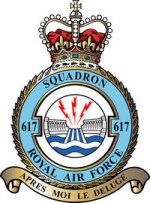 It is unfair to single out any squadron of Bomber Command for special attention, as all performed magnificently during WWII, all suffered very heavy losses.
It is unfair to single out any squadron of Bomber Command for special attention, as all performed magnificently during WWII, all suffered very heavy losses.
I feel a blow has been struck at Germany from which she cannot recover for several years. -- Barnes Wallis
 It is unfair to single out any squadron of Bomber Command for special attention, as all performed magnificently during WWII, all suffered very heavy losses.
It is unfair to single out any squadron of Bomber Command for special attention, as all performed magnificently during WWII, all suffered very heavy losses.
Dambusters, 617 Squadron, is though probably the best known of all the Bomber Command squadrons, because of its daring bombing raid in Germany where it destroyed dams in the Ruhr Valley using the revolutionary bouncing bomb invented by Barnes Wallis.
A mission immortalised in the 1950s film The Dam Busters co-starring Richard Todd (as Guy Gibson) and Sir Michael Redgrave (as Barnes Wallis).
The damage wrought when Hurricane Katrina hit new Orleans in August 2005 gives some idea of the damage caused in the Ruhr Valley by breaching the dams.
Destroying the Ruhr Valley dams would not only wreak havoc with the release of water, damage that would require a large number of bombing raids, it would also deny the Germans hydroelectric power, deny water to their extensive canal network, and deny water to war production.
It would have been a relatively simple operation to have dropped torpedoes, only this was not possible as the Germans had hung anti-torpedo netting to protect the dams. A bomb also had the added advantage of being able to carry a heavier explosive payload.
Barnes Wallis tried some experiments on a scale model dam. He found that a 10-ton bomb dropped near the wall of the dam would leave the dam unscathed, and even that would need a specially designed aircraft to carry the bomb. At least a 30-ton bomb would be needed and an aircraft to carry such a bomb would not be possible.
The problem was the water was cushioning the impact of the bomb, leaving the dam without a scratch.
Wallis then had the brilliant idea of dropping a bomb against the wall of the dam. The water would then have the effect of deflecting the explosion into the wall of the dam. A much smaller bomb would now be required, as Wallis demonstrated on his scale models. A bomb that could be carried by an existing, possibly with modifications, Avro Lancaster.
Now all what was left was how to place the bomb adjacent to the dam.
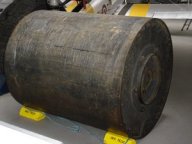 Wallis then had his second brainwave, a 'bouncing bomb'.
Wallis then had his second brainwave, a 'bouncing bomb'.
Bouncing cannonballs had been used by the Navy in the 19th century, and it was from here he had got his original idea, and had already carried out some experimental work for the Navy.
A bouncing bomb would require precision bombing, too short, and the bomb would fall short, too near, and it would bounce over the dam.
The next problem was to convince the committee of Whitehall mandarins that this crazy idea would work. [It is disputed that Wallis had to convince Whitehall that his idea would work]
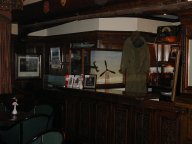 Based at RAF Scampton, a few miles north of Lincoln, 617 Squadron, led by Wing Commander Guy Gibson, was specially formed to handle the Dambusters raid. All the crews were hand-picked for the squadron.
Based at RAF Scampton, a few miles north of Lincoln, 617 Squadron, led by Wing Commander Guy Gibson, was specially formed to handle the Dambusters raid. All the crews were hand-picked for the squadron.
A specially modified Lancaster was needed for the raids. The bomb was slung below the plane. On approach to the target, the bomb spun up to 500rpm. This backwards spin caused the bomb to bounce, on hitting the wall of the dam, the backwards spin would pull it down the wall of the dam into the base of the dam. A hydrostatic fuse was set for 30ft, and failing that, a delayed detonation.
Details of the bouncing bomb and its release mechanism were kept secret until 1974.
After the raids the Germans managed to recover one of the bouncing bombs that had not exploded. They carried out their own work using the bombs, but had to abandon their trials as the bombs had a nasty habit of catching up with and destroying the release aircraft.
The bombs had to be dropped from an exact height of 60ft. Barometric altimeters were not sufficiently accurate. Spotlights were aimed at an angle at the ground. When the two spots on the water merged into one, the aircraft would be at an exact height of 60ft.
617 Squadron practised their bombing raids on Derwent Water. Such was the delicacy of the operation that not even the crews knew what their final target would be. A rumour was spread that it would be the German battleship Tirpitz, holed up in a Norwegian fjord. Ironic, in that later in the war, Tirpitz was bombed by 617 Squadron.
The Lancasters used in the raid, had their armour removed to reduce the weight.
The attack, code name Operation Chastise, on the night of the 17th of May 1943, was in three waves.
The aircraft crossed into occupied Europe at two locations, flying low-level all the way.
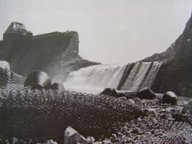 Guy Gibson led the first wave, which was to attack the Moehne, and after that, if aircraft were left with any bombs, to attack the Eder.
Guy Gibson led the first wave, which was to attack the Moehne, and after that, if aircraft were left with any bombs, to attack the Eder.
The entire mission was a suicide mission. Gibson had the element of surprise. After that the Germans knew what to expect. The aircraft had to line up to have any success of accurate delivery of their payloads, which turned them into sitting ducks for the Germans to aim at.
Gibson was not successful, and then tried to draw the flak away from the other aircraft. The second aircraft was hit by flak, then caught in the blast from its own bomb and destroyed. The third aircraft was successful. Two more successful runs, and the dam was breached.
Gibson then led the formation on to the Eder. The first aircraft had six unsuccessful runs, then took a break. The bomb from the second aircraft hit the top of the dam and the blast destroyed the aircraft. The first aircraft then made a successful run and with a hit by a third aircraft, the dam was breached.
The second wave successfully attacked the Sorpe dam, but the dam was not breached.
The third wave was a reserve wave, and they were now directed to the Sorpe, but were not successful in breaching the dam. They were directed to subsidiary targets.
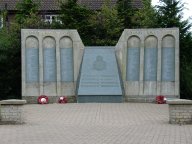 Of the 133 aircrew 53 were killed and three bailed out to be made POWs. Of the surviving aircrew thirty-three were decorated at Buckingham Palace on 22 June, with Wing Commander Gibson awarded the Victoria Cross. In total there was one VC, five DSOs, ten DFCs and four bars, twelve DFMs and two CGMs.
Of the 133 aircrew 53 were killed and three bailed out to be made POWs. Of the surviving aircrew thirty-three were decorated at Buckingham Palace on 22 June, with Wing Commander Gibson awarded the Victoria Cross. In total there was one VC, five DSOs, ten DFCs and four bars, twelve DFMs and two CGMs.
Gibson embarked on a public relations tour of America. On his return to operational duty he was killed on a mission in 1944.
Around 330 million tons of water poured into the western Ruhr region. Mines were flooded, houses, factories, roads, railways and bridges destroyed as the flood waters spread for around 50 miles (80 km) from the source. Estimates show that before 15 May 1943 water production on the Ruhr was 1 million tonnes, which dropped to a quarter of that level after the raid. In terms of deaths: 1,294 people were killed, 749 of them Ukrainian POWs from a camp just below the Eder Dam.
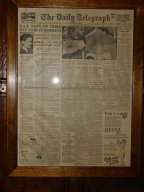 The impact, if any, of Operation Chastise on the German war effort was short-lived, and it did not have the military impact that military planners had anticipated. By 27 June, little over a month after the raid, full water output was restored, thanks to an emergency pumping scheme inaugurated only the previous year, and the electricity grid was again producing power at full capacity. The raid proved to be costly in lives (more than half the lives lost belonging to allied POWs). In the long term, it proved to be little more than a minor inconvenience to the Ruhr's industrial output. A beneficial side effect was that 27,000 men were withdrawn from Atlantic Wall defences to rebuild the dams and 10,000 men were allocated to protect Germany's other dams in expectation of further raids, although no further dam raids took place.
The impact, if any, of Operation Chastise on the German war effort was short-lived, and it did not have the military impact that military planners had anticipated. By 27 June, little over a month after the raid, full water output was restored, thanks to an emergency pumping scheme inaugurated only the previous year, and the electricity grid was again producing power at full capacity. The raid proved to be costly in lives (more than half the lives lost belonging to allied POWs). In the long term, it proved to be little more than a minor inconvenience to the Ruhr's industrial output. A beneficial side effect was that 27,000 men were withdrawn from Atlantic Wall defences to rebuild the dams and 10,000 men were allocated to protect Germany's other dams in expectation of further raids, although no further dam raids took place.
Where the raid did have an impact, was that the pictures of the broken dams proved to be a huge morale boost to the Allies, especially to the British, suffering under German bombing. It also told the Germans, the British could strike at the heart of their war machine. Maybe even more important, it showed the Americans and the Russians, what the British were capable of.
After the Dambusters raid, no similar raid was mounted as it had proved to be too expensive in both men and aircraft lost. Barnes Wallis and 617 Squadron continued to work together.
Tallboy and Grand Slam ground-penetrating 'earthquake' bombs were two very heavy bombs, developed by Barnes Wallis and delivered by 617 Squadron.
One noticeable mission was the sinking of the German battleship the Tirpitz, sister ship of the Bismark.
617 Squadron continue to be pioneers in bombing raids. Now flying Tornadoes, 617 Squadron was the first RAF squadron to fire the MBDA Storm Shadow cruise-missile during the 2003 illegal Invasion of Iraq.
617 Squadron was originally based at RAF Scampton, then RAF Coningsby, then RAF Woodhall Spa, now at RAF Lossiemouth in Scotland.
Not far from Woodhall Spa is Thorpe Camp and the Lincolnshire Aviation Heritage Centre. Both sites have exhibitions on the Dambusters Raid and the sinking of the Tirpitz.
Thorpe Camp, near Tattershall Thorpe, looks not much from the outside, just a handful of huts, is all that remains of RAF Woohall Spa. It was here that 617 Squadron were based as a specialist unit delivering heavy bombs. Thorpe Camp has it has a number of interesting exhibits, including the Dambusters raid and the sinking of the Tirpitz.
Lincolnshire Aviation Heritage Centre, at what was once RAF East Kirkby, was established by the Panton Brothers, Fred and Harold Panton, as a memorial to their elder brother Pilot Officer Christopher Panton, who along with 55,000 other aircrew of Bomber Command lost their lives during WWII. The Centre has both a Spitfire and a Lancaster from WWII and a large number of interesting exhibits, including the Dambusters raid and the sinking of the Tirpitz, making it probably the most important aviation heritage centre in the country.
In the centre of Woodhall Spa is a very impressive memorial to the Dambuster Squadron. Also at Woodhall Spa, Petwood Hotel, requisitioned during the latter half of WWII as the Officers Mess for 617 Squadron. The Squadron Bar has memorabilia from the period. In the grounds can be found one of the practice bouncing bombs.
 The Petwood Hotel now has a more peaceful role, being a favourite spot to hold wedding receptions.
The Petwood Hotel now has a more peaceful role, being a favourite spot to hold wedding receptions.
The Blue Bell Inn, a very old roadside inn at Tattershall Thorpe, serves excellent food and a good choice of real ales. Apart from being an interesting old inn and serving excellent food, another reason for visiting the Blue Bell Inn, is that on the ceiling of the old bar are signatures of members of 617 Squadron.
RAF Coningsby, now home to the Battle of Britain Memorial Flight, is still an active RAF base
To commemorate the 60th anniversary of the Dambusters raid, a Lancaster from the Battle of Britain Memorial Flight flew around the country visiting all the sites associated with the Dambusters. At Brooklands, as part of the anniversary, model airplane enthusiasts were invited to bring along their model Lancasters and mount raids on a model dam.
RAF Scampton, for a while mothballed, is now home to the world famous Red Arrows.
Richard Todd, who plays the part of Guy Gibson in the film, took part in the airborne assault on Pegasus Bridge on D-Day.
The Upper Derwent Valley in Derbyshire, the practice area for the real raids, took the part of the Ruhr Valley, the scene where the Dutch coast is crossed was filmed between Boston and Kings Lynn, and other coastal scenes near Skegness. The airfield used was RAF Hemswell, a few miles north of Scampton. Hemswell was operational during the war, but not when the filming took place.
The Dam Busters was to influence later films.
The attack on the Death Star in the the film Star Wars Episode IV: A New Hope is similar in many respects to the strategy of Operation Chastise — rebel pilots have to fly through a trench while evading enemy fire and drop a single special weapon at a precise distance from the target in order to destroy the entire base with a single explosion, if one run fails another run must be made by another pilot. The scenes from Star Wars are very similar to those in The Dam Busters with a near identical dialogue.
In an example of political correctness gone mad, the scenes in The Dam Busters with Guy Gibson's dog Nigger had to be cut when the film was shown on ITV in case the use of the word 'nigger' should cause offence.
The Wall, both the album and the film, by Pink Floyd, contains extracts from The Dam Busters where Guy Gibson's dog Nigger is run down and killed by a car before the planes take off. A bad omen if ever there was one.
 The 1950s film The Dam Busters co-starring Richard Todd (as Guy Gibson) and Sir Michael Redgrave (as Barnes Wallis), the film which imortalised the Dambusters on the silver screen, was based on two books, The Dam Busters by Paul Brickhill and Enemy Coast Ahead by Guy Gibson.
The 1950s film The Dam Busters co-starring Richard Todd (as Guy Gibson) and Sir Michael Redgrave (as Barnes Wallis), the film which imortalised the Dambusters on the silver screen, was based on two books, The Dam Busters by Paul Brickhill and Enemy Coast Ahead by Guy Gibson.
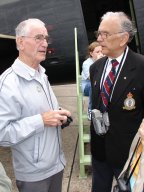 Talking to a pilot and navigator of one of the three Lancasters used in the film, it is surprising the steps taken to ensure accuracy. One of the major departures from reality was the bouncing bomb and its release mechanism, as at the time both were still Top Secret.
Talking to a pilot and navigator of one of the three Lancasters used in the film, it is surprising the steps taken to ensure accuracy. One of the major departures from reality was the bouncing bomb and its release mechanism, as at the time both were still Top Secret.